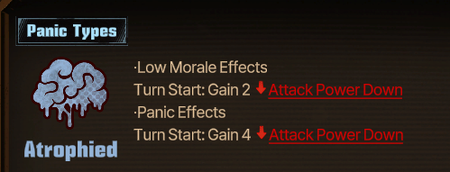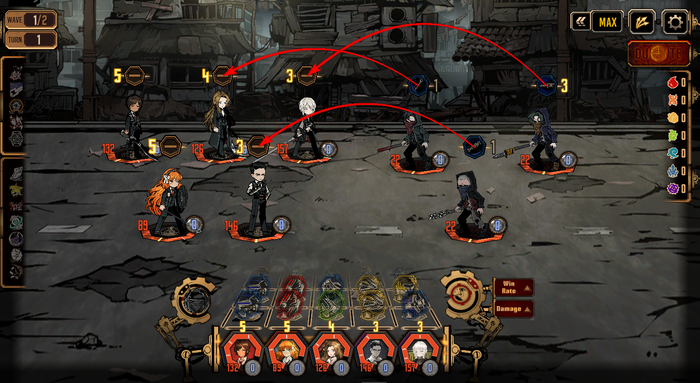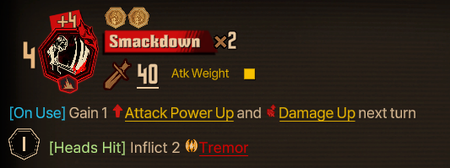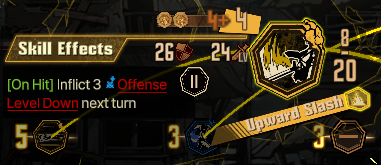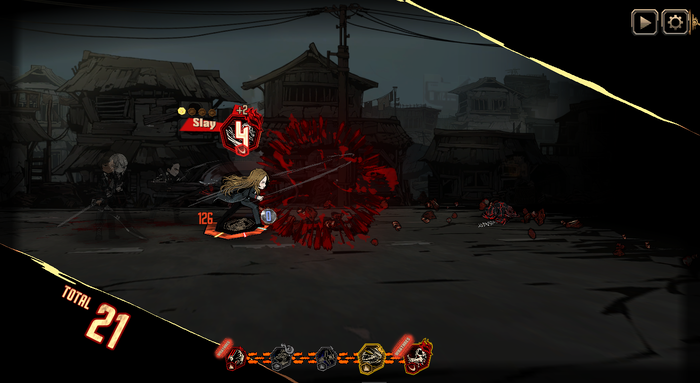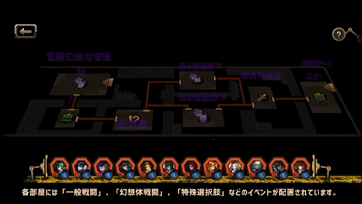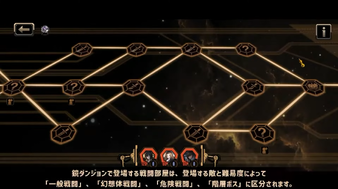Battles
GENERAL COMBAT MECHANICS
Gameplay is centered around assembling a small team from the available twelve (12) Sinners (Yi Sang, Faust, Don Quixote, Ryoshu, Meursault, Hong Lu, Heathcliff, Ishmael, Rodion, Sinclair, Outis, and Gregor) and entering combat encounters with a selection of different enemies. Sinners and enemies will take turns selecting skills to attack or "clash" with each other over several turns. Combat ends when one side's units have been completely defeated, the battle win or fail conditions have been met, or 100 turns have passed ("overclocked").
Combat Mechanics
Currently combat is centered around five main mechanics: speed, sanity, resistances, health, and stagger.
Speed
Speed is a random number assigned to a unit chosen from a given range each turn. All Identities have their own speed ranges, regardless of faction relation or base Sinner Identity. On both the battlefield and the skill dashboard, Sinners are sorted by their randomly rolled speed with the fastest units on the leftmost side, to the slowest units on the rightmost side. The higher the value, the faster the unit is for that turn. In General Encounters, units with high speed prioritize attacking units with low speed. When Sinners receive the same speed, the order of their attacks is based on who was chosen first in the character selection screen before the battle. In Focused Encounters, sinners with higher speed may redirect an attack of an enemy currently targeting another sinner with their own skill. Offensive skills force the enemy to clash against that skill instead. Defensive skills simply redirect the skill to target the sinner.
Sanity
Sanity is determined through several interactions that occur in and out of combat. Sanity Points (SP) are represented as a blue or red number that can be seen on the unit's portrait under the skill dashboard and under their character sprite on the battlefield right next to their health bar. Sanity ranges from -45 to 45 and directly affects the chance of a unit hitting Heads whenever they flip a skill coin. At zero (0) sanity, the unit's chances of hitting Heads is 50%. Each additional point of sanity corresponds to a change of 1% to the Heads rate. In normal combat encounters (outside of Dungeons and Refraction Railway), all Sinners and enemies usually start at zero (0) sanity. The main way to gain sanity is by winning clashes or defeating enemies. Sanity is most commonly lost by using E.G.O, losing allies, and other status effects such as Sinking.
Reaching -30 or below SP may cause "Low Morale" on any enemy with SP, reducing their skill effectiveness against clashes and one-sided attacks. Furthermore, hitting -45 will immediately cause "Panic", akin to being Staggered, preventing any action until the next turn (where the unit will be reset to 0 SP). If a Sinner reaches -45 and has an E.G.O other than their personal ZAYIN equipped, they are forced into E.G.O Corrosion, in which they will use a corroded E.G.O skill against the player's decision. Abnormalities and hostiles without sanity cannot gain the advantages and disadvantages of sanity, with solely a 50% base chance to roll Heads. If inflicted with Sinking, a status effect that reduces SP per hit, the Abnormality takes direct Gloom damage instead.
Resistances
Resistances are multipliers factored on top of incoming damage, determining the final amount of damage a unit takes from a certain attack. All characters have resistance multipliers to both physical damage types (slash, blunt, pierce) and Sin Affinities (wrath, lust, sloth, gluttony, gloom, pride, envy). Every offensive and counter skill possesses a physical damage type and Sin Affinity that can affect the total damage dealt to the enemy depending on their resistances.
Resistances are multiplicative. Every Identity and most enemies encountered usually have one damage type they take fatal damage against (2x), one damage type they take normal damage against (1x), and one damage type that is ineffective against them. (x0.5). In some cases, enemies can also be weak to (x1.2, x1.25 or x1.5) or endure (x0.75) certain physical damage types.
Every Sinner gains Sin Affinity resistances based on the most recently used E.G.O. If no E.G.O has been used since the start of the battle, the Sinner's resistances are that of their equipped ZAYIN E.G.O. For enemies, only Abnormalities, E.G.O-possessing human enemies, Distortions, and certain bosses possess unique Sin Affinity resistances. Normal human enemies do not possess special Sin Affinity resistances, all Sin Affinities deal normal (1x) damage to them. Sinner's E.G.O and Enemies that do have special resistances against Sin Affinities can take fatal (2x), weak (1.2x, 1.25x or 1.5x), normal (1x), endured (0.75x), or ineffective (0.5x) damage depending on the Sin Affinity of the attack taken.
Health
Health is the red bar and correlated number under a unit's sprite. This same bar can be seen surrounding an ally unit's portrait under the Skill Dashboard. Health determines how much damage a unit can take before they are killed in combat. The objective of most combat encounters is to reduce all of the enemies' health to 0. If the health of all sinners is reduced to 0, the combat encounter is lost.
Stagger
Stagger is a mechanic that punishes suboptimal skill selection, clashing, or unit targeting. Stagger Thresholds are represented by small lines on health bars of sinners and enemies alike, and can have their numerical value viewed in the unit's information menu. When a unit takes enough damage that a Stagger Threshold is surpassed, the unit will become Staggered and will be unable to use their skills for the current and subsequent turn of combat. Additionally, a staggered unit will have all their physical resistances changed to Fatal during the turn. If a staggered unit is dealt enough damage to the point of reaching the next Stagger Threshold within the same turn, the unit will gain Stagger+ or Stagger++, becoming increasingly more vulnerable to damage.
Resistances to Sin Affinities are usually unchanged by the Staggered status. Sinners can have anywhere from one (1) to three (3) Stagger Thresholds, depending on the equipped Identity. Enemies can have varying amounts of Stagger Thresholds.
Attacking in Limbus Company
Every single unit--both ally and enemy--has a set of Skills and Passives that they can use during combat. Every Sinner Identity currently has at least three (3) skills and one (1) defense skill that can be used during their turn. Additionally, they each have an Active and Support Passive which can be independently activated depending on whether they are placed in combat or out of combat, respectively.
Coin Flips
Each Skill in the game has a certain number of "coins" that are flipped to achieve different effects. Coins, depending on whether or not they flip Heads during combat, can positively or negatively affect the damage dealt by the Skill being used. The probability of hitting Heads is affected by the unit's Sanity. Skills and the significance of Coins/Coin Power are expanded on in the Battle Information section.
Offensive Skills
Each Sinner is given at least three offensive skills with varying degrees of power. All Identities can immediately access their Skill 1 and Skill 2. Skill 3 is unlocked once the Identity is Uptied to tier 3. Skills and Passives are upgraded with each Uptie. In combat, Sinners pull Skills out of a "skill deck" which contains a certain number of each skill and will only refresh after all skills have been used. Skill 1 is commonly the weakest, with up to three (3) copies of the skill being available on a skill deck; these skills are usually fodder meant to be rotated out for stronger skills. Skill 2 is utility or setup, with up to two (2) copies of itself in a deck; these skills maximize the effect of a unit's deck. Skill 3 is often the central and most powerful Skill of any unit's Skillset; only one (1) of this Skill can be on a deck at a time.
Offense and Defense Levels
Offense and Defense Levels are stats every unit possesses that scale with their level and affect the Clashing Power and damage of Skills. Every unit possesses a base Offense Level equal to their level. The Offense Level is applied to all of the units skills as well as E.G.O. Each offensive skill may also possess an offense level modifier specific for that skill that either increases or decreases the overall Offense Level. Similarly, every unit also possesses a Defense Level equal to their current level and the unit's Defense Level modifier.
Offense and Defense Levels affect combat in two ways:
- In a clash between two Offensive Skills, the character with the higher Offense Level gains +1 final Clashing Power for every three (3) Offense Level difference. In a clash between an Offensive and Defensive Skill, the Offensive Skill cannot gain power from Offense Level, but the Defense Skill can gain +1 clash power for every three (3) Defense Level they have over the opponent's Offense Level.
- When attacking, the difference between Offense and Defense Levels additionally modifies the damage dealt on top of resistances. For every point of Offense Level of the attacking skill above the Defense Level of the attacked target, the Skill deals 3% more damage. Inversely, for every point of Defense Level the attacked target has above the Offense Level of the attacking Skill, the Skill deals 3% less damage.
Offense-oriented units usually possess Skills with positive Offense modifiers but possess negative Defense Level modifiers, while defense-oriented units often possess negative Offense Level modifiers and positive Defense Level modifiers. Status Effects such as Offense Level Up/Down or Defense Level Up/Down--applied through Skills or Passive effects--further impact a unit's Offense and Defense Levels.
Defense Skills
There are three types of Defense Skills: Block (shield), Evade (circular arrow), and Counter (sword and shield). They can be produced by pressing on a unit's portrait on the Skill Dashboard. Defense Skills can be created without limit and fully replace the bottom skill if used. They can be undone before combat by pressing on the skill's portrait again. Most Block and Evade skills possess no Sin Affinity before upgrading that identity to Uptie 4. They get no bonus from Sin Resonance, but generate sin resources if the skill gets used. E.g., defending against an enemy's empty or Defense Skill slot will not generate resources nor trigger the ally unit's Skill [On Use] effect(s). Counter Skills possess Sin Affinities regardless of Uptie Level and gain Offense Level bonuses from Sin Resonances. Clashing any Defense Skill with an opponent's Dodge or Evade causes an "Offset," which cancels the use of both skills. This cancels [On Use] effects, but not [Combat Start] effects.
Block
Block Skills activate when the unit with the selected Skill uses it during a turn before being attacked by an incoming offensive Skill. Block Skills generate a temporary amount of shield health for the duration of the turn equal to the rolled value, indicated by a blue health bar added to the unit's red health bar. Shield HP essentially acts as "bonus health" that is lost first before the actual health of the defender. Resistances affect how much damage the shield takes. Any leftover shield HP that remained until the end of a turn disappears at the start of the following turn. Shields may also be generated through certain Skills' effects, such as those of Dieci Rodion, Dieci Yi Sang, Zwei Association Gregor, and Zwei Association Rodion.
Evade
Evade Skills activate when the unit with the selected skill uses it during a turn before being attacked by an incoming offensive Skill. While active, an Evade Skill allows a unit to dodge attacks that are of equal or lesser power than the incoming Skill's Final Power. The Evade Skill's coin is flipped each time an Opposing Skill flips its coin. When a unit activates their evade skill, that skill remains active for the duration of the turn. Evading an attack causes the defending unit to take no damage. However, if an Evade Skill's Final Power is less than the opposing Skill's Current Power, the defending unit takes the full damage and the Evade Skill is lost. If an Evade Skill manages to evade an entire opposing Skill, it will be reused for any other incoming Skills, even if only one Evade Skill was used. The Skill is considered as used even if the first Evade was unsuccessful. However, even if the unit evades different attacks, it's only used once ([On Evade] effects are activated at each Coin evaded, regardless if it's during different attacks or a single multi-coin attack).
Counter
Counter skills activate when the unit who selected the skill uses it during a turn after being attacked by an incoming offensive Skill. A unit using the selected Counter Skill immediately launches a one-sided counterattack against any enemy who attacks them, regardless of which enemy the Defense Skill had targeted prior. When a unit has several Skill slots, selecting the Counter Skill multiple times on the Skill Dashboard increases the number of times that unit can engage in a counterattack. Units that are staggered by an attack cannot use a Counter Skill afterward. Counter Skills possess a physical damage type and a Sin Affinity, both affecting the damage dealt to the enemy.
Passives
Passives are some of the most important parts of an Identity's kit, as they can greatly benefit or ruin depending on their effects and activation requirements. There are two types of passives, Combat and Support, and all Identities possess one of both types. An Identity's Combat Passive is used while the Identity is deployed in combat, usually only affecting themselves (unless stated otherwise). An Identity Support Passive is used while the Identity is not deployed in combat, but is equipped on the team. These Passives usually only affect one deployed ally unit in battle that meets certain criteria, such as having the most or least sanity or health (unless stated otherwise). If two or more units in combat meet the same criteria, the unit selected first on the pre-battle screen has priority for the Passive's effect.
Both Combat Passives and Support Passives activate under certain conditions related to the sin resources or the Sin Resonance. Passives that activate via Sin Resonance require a certain Sin Resonance (whether general or Absolute Resonance) of a specific Sin Affinity to be achieved on that turn. Passives that activate via possessed sin resonances require a certain amount of one sin type's sin resource in possession in order to activate.
Durante (Sapling of Light)
Unlocked after Canto 6-44, this allows Dante to activate a Golden Bough ability. Abilities can be activated only once per day (as of Canto VI) and more abilities get unlocked as you progress through Inferno.
DURANTE
| ||||
|---|---|---|---|---|
| Icon | Sephirah | Ability Name | Effect | Unlock Requirement |

|
Hokma | Pigritia | Halves the current speed of all the living enemies. | Unlocked after 6-44 |
BATTLE INFORMATION
Every Skill in Limbus Company has seven key components: Sin Affinity, damage type, number of attacks, base power, coin power, attack weight, and offense level.
The Sin Affinity of a skill can be determined by the skill's color and a decoration on the top right of its border.
Red (Wrath), Orange (Lust), Yellow (Sloth), Green (Gluttony), Light Blue (Gloom), Dark Blue (Pride), and Purple (Envy).
The skill's damage type is displayed on the bottom, being one of the three types--slash, pierce, and blunt. All units, both ally and enemy, have varying weaknesses and resistances toward different Sin Affinities and damage types.
The number of attacks a skill has is represented by the amount of coins displayed above the skill's title. All skills will have at least one coin.
The skill's base power is shown on the left of its icon, while its coin power is shown on top. The coin power dictates the value added to or subtracted from the base power if the coin flip lands on Heads. All coins are flipped individually, each being one attack in a sequence, after winning a clash, and will determine the damage the skill does. An attack will land regardless of Heads or Tails, but flipping Heads will increase the damage dealt.
Attack weight (abbreviated to Atk Weight) is underneath the skill's title and is accompanied by at least one yellow square. Each yellow square represents a skill slot that the attack will hit. Note that some stronger enemies may have skill slots that will take up more than one attack weight.
Offense level is the number to the left of attack weight, next to a sword icon. Offense Level is the sum of the ID's level and an offense level modifier, which can range from -5 to 5. It will be further discussed next in its use during clashes.
In battles, before the turn commences, the menu atop the screen displays a clash preview. Alongside the previously mentioned skill details, superior Offensive and Defensive Levels are shown and highlighted.
Additionally, the chance to win the clash is displayed in the top center as a percentage, dictating how much stronger or weaker the attack's damage will be depending on various factors such as resistance and level differences.
During one-sided attacks, the clash prediction turns into a damage prediction, showing the minimum and maximum damage the attack will deal.
Each attack has two phases: a clash phase and a 'one-sided' attack phase.
Clashes occur when two units attack each other with a skill. When a unit clashes with another, both units flip all of their skill's coins; this determines the skill's power in a clash. The unit whose skill has the lowest clash power loses one skill coin, and if the unit still has one or more skill coins left, the two units clash again. Once one unit has lost all its skill coins, the victor becomes the attacker in the one-sided phase, attacking with its remaining skill coins.
An additional modifier that can affect the outcome of a clash involves a difference in Offense Levels. Within a clash, for each three (3) points of difference, the unit with the higher has against their opponent, they gain one (+1) Clash Power. This additional clash power is only factored in during clashes and is not kept as a damage increase if the clash is won.
After each turn, depending on the order of the sinners the player had selected at the pre-battle screen, the first sinner will receive another action followed by the next sinner, and so on. Once all ally units have received a second skill slot, the process will begin at the first selected once again, giving them an additional skill slot. A maximum of 12 skill slots can be on the dashboard during General Battles. Likewise, enemies' skill slots will also increase each turn.
Focused Battles
Focused Battles are mechanically different from General Battles. Enemies featured within Focused Battles are commonly Abnormalities or notable adversaries within the game's story. Said enemies tend to have several skill slots and may or may not be accompanied by lesser, more common enemies found in General Battles. Unlike General Battles, which do not allow the player to direct each Sinner's attacks manually and are instead dictated by the dashboard chain, Focused Battles allow for the player's discretion in which enemy/skill slot to clash with. Often, a maximum of six (6) Sinners can be selected for a battle. Unlike General Battles, the Sinners will not gain additional skill slots during subsequent turns if the maximum number of units were deployed. If fewer units than the maximum were deployed, then the Sinners will gain one skill slot in order of their selection on the pre-battle screen until the number of skill slots hits the maximum number originally outlined--e.g., if five (5) units were deployed in a battle with a maximum of six (6), then only the first selected unit in the pre-battle screen will gain an additional skill slot.
In the case of Abnormalities, they will often possess more than just Body part skill slots. These can be differentiated via small icons above the skill slot--ribs (body), hand, feet, and skull. Note that even if several skill slots have the same icon, it does not necessarily mean that it is correlated to the same part of the body, as some Abnormalities may have features such as more than one body or head. Each part will have its own skill set which can be viewed in detail by opening the Abnormality's information while in battle and clicking on a designated health bar displayed atop the Abnormality's specific part. Each part may be labeled as destructible/indestructible and severable/inseverable. A destroyable part is considered destroyed if its health is reduced to zero (0), and it will be significantly more susceptible to attacks. However, they can still use a skill in said destroyed part's skill slot, and for some Abnormalities, the destroyed part may regenerate to full health after a certain amount of turns. Severed parts are considered completely removed from the abnormality, reducing a skill slot. This may be represented as the severed skill slot being shown as shattered, and it will not be selectable for any skill by the player.
Within certain Focused Battles, there will be Choice Events in which a Sin Affinity check is proposed toward the player. Within these Choice Events, the player must select a sinner that would ideally pass the requisite number, the result of which is dictated by the coin flips of a skill from their kit that corresponds with the Sin Affinity check. As the check's result relies on coin flips, the higher a Sinner's SP, the more likely they are to hit heads which will greatly influence the outcome. Depending on the result, the check is deemed a success or failure. The consequences of both success and failure vary across the Choice Events for each Abnormality, and the consequences of success are not always without fault. Both success and failure may apply a negative status or positive buff to the enemy or the player's units. Although the Choice Events vary across all different Abnormalities, the Choice Events for a particular Abnormality will always be the same and have the same results.
In the story and the Mirror Dungeons, the additional difficulty of a focused battle may reward the player with an E.G.O Gift. All E.G.O. Gifts may have positive or negative effects on player or enemy units and are beneficial if used alongside a team that can best utilize them.
Dungeons
STORY DUNGEON
Story Dungeon is a rouge-like battle and exploration type of gameplay that explores a derelict section of the L Corp branch, a section containing a Golden Bough These are unlocked when you reached near the end of some of the Canto.
In story dungeon, you move step-by-step by moving in "rooms", each containing events in them. These events will either be a General battle, Abnormality battle or "Special Options". With every battle you face, the sinners' sanity level, health, and the number of sinners will not be restored after you finish a battle. They will remain as they are, from what you've left off.
Once you clear the first layer of the dungeon, you can continue on another layer with a different map. At the end of the dungeon lies the Golden Bough, which will be your main target for Story Dungeons.
Resting Point
There are also designated Resting Points, where you can heal your sinners and save your progress. If by chance, you lose a battle, you are allowed to use the other remaining Identity. However, if you've lost all of your Identities, you will go back to your previous resting point, or the place where you've started.
MIRROR DUNGEON
Mirror Dungeons are similar to Story Dungeons, with it's rouge-like settings. Despite this, there's a few differences.
- You can enter the dungeon for free. However, reward claiming requires 5 Enkephalin Modules.
- All the sinners can be brought to the dungeon, but one identity and all E.G.Os you have obtained from them are affixed on the group you sent to. Their maximum level (for hard mode) and grade from Uplift/Threadspin will be carried over.
- You will be given a choice of a variety of E.G.O Gift to choose from based on their effect that could potentially help the sinners, or simply refuse to do so. These gifts are especially important due to the buffs they grant.
- Depending on how many floors you have cleared and the type of Mirror Dungeon, you'll gain EXP for the Battle Pass and earn rewards from it. You can only claim the weekly bonus up to 3 times per weekly reset, or choose not to use the bonus.
There are more key differences in Mirror Dungeon compared to Story Dungeons during the progress:
- Unlike story dungeons, each type of Mirror Dungeon are randomly generated per level, and based off several chapters branched between.
- Every battle have a chance of allowing you to earn some cost based on the type of battle encounter. You may also have a chance of obtained an E.G.O Gift as well.
- Certain nodes allows you to spend your Cost obtained from events and battle encounters, such as replacing skill coins with a stronger variant, buying an E.G.O Gift displayed, or getting new sinner, identities and/or E.G.O, up to 3 sinner purchases per encounter. Sinner-exclusive ZAYIN-Risk E.G.O are free of charge.
- Similar to story dungeon, health and sanity of Sinners do not regenerate. Unlike it though, if the sinners die, they stay dead for the duration of the mirror dungeon. Moreover, if all the sinners are killed, the exploration will end in defeat as there are no checkpoint. You can, however, stop or continue at any point of time and continue from where you've last left off.
- There is an event marked with a chair mark, which allows the manager to have either the living sinner with the lowest heath to recover by 30%, or have all wounded living sinners to recover at 10%. Optionally, this area also allows purchases of new sinners, identities and/or E.G.O.
- Some E.G.O Gift and Sin Resonances with specific Sinner+Identity can also heal badly-wounded sinners.
- Events (marked with a question mark) will generate a random event instead of ones tied to the story, sometimes generating E.G.O Gift if the right choice is selected (with the right sinner to roll the coin number, and sometimes with a catch).
- The last floor of the dungeon will always feature a random major enemy. There are a few type of abnormality that only exists exclusively in this mode.
- Every Season, the features of the Mirror Dungeon will alternate itself, requiring managers to adapt and strategize on their gameplay.
FATHOMS
Fathoms acts as a mixture between Story Dungeon and Mirror Dungeon. These only usually exists at the end of some of Intervallo Chapters, and delves the sinners into the minds of a Distortion who either have their minds opened up, or escaped to another reality. These requires Enkephalin Modules to enter.
They behaves similar to that of Mirror Dungeon with only one floor, but mainly features their story-exclusive E.G.O Gift, Enemies and bosses.
Trivia
- Focused battles are similar to the battle mechanics at Library of Ruina, except the number of actions are limited by the number of maximum sinners that can be deployed.
| Mechanics | Battles - Battle Announcers - E.G.O - Identities - Items - Luxcavation - Mirror Dungeon - Story Dungeon - Theater |
| Seasonal Event | Seasons - Limbus Pass - Refraction Railway - Dante's Notes - Walpurgis Night |
| Characters | Dante - Vergilius - Charon |
| Sinners |
|
| Terminology | |
| Locations | The City (Districts (Nests • Backstreets)) - Outskirts - The Great Lake - Mephistopheles |
| Lore | Abnormalities - E.G.O - Distortion - The Sign - Smoke War - Singularity - Golden Bough |
| Factions | Limbus Company - Fixers (Offices • Associations) - Syndicates (Five Fingers) - Wings |
| Other | |
| Songs | "In Hell We Live, Lament" - "Between Two Worlds" - "Fly, My Wings" - "Compass" - "Through Patches of Violet" - "Pass On" |
| Media | Lobotomy Corporation - WonderLab - Library Of Ruina - The Distortion Detective - Leviathan - Limbus Company (Game) |


